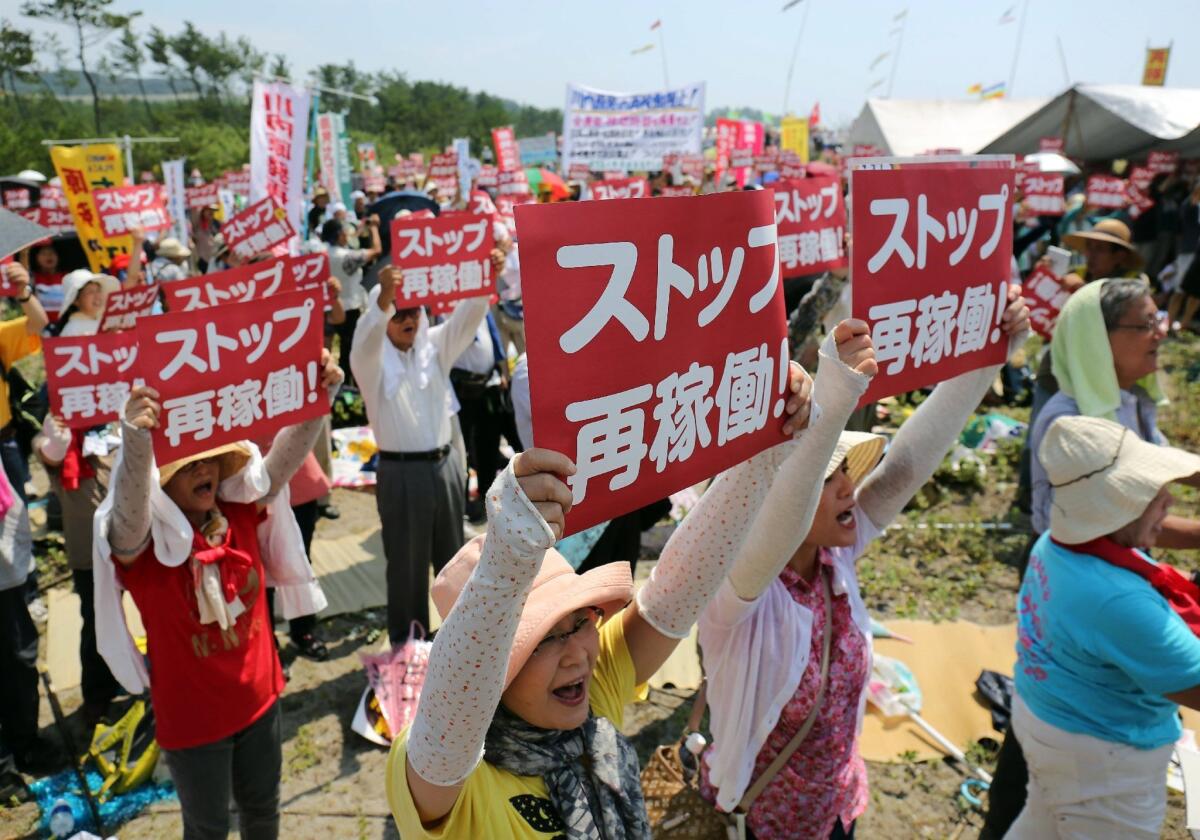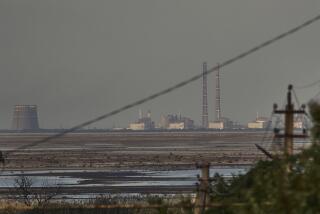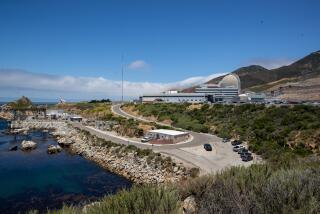Japan restarts nuclear reactor, 4 years after Fukushima. What’s at stake?

Protesters rally Aug. 9 on Japan’s southern island of Kyushuanti against the decision to restart a reactor at the Kyushu Electric Power Co.’s Sendai nuclear plant.
Amid substantial public opposition, Japan on Tuesday restarted one of more than 40 atomic reactors that were taken out of service in wake of the 2011 Fukushima nuclear disaster. Kyushu Electric Power Co. said it had restarted the No. 1 reactor at its Sendai plant in Kagoshima prefecture about 600 miles southwest of Tokyo. The facility was expected to start generating electricity by the end of the week and return to full output by early September, operators said.
A complex mix of factors is behind the move. Here’s a look at some of the issues.
Why is the government moving ahead with restarts?
Nuclear power provided about 30% of Japan’s energy before the Fukushima accident, the worst nuclear disaster since Chernobyl. After the meltdown, Japan took its reactors offline, and the government led by Prime Minister Naoto Kan announced a plan to phase out nuclear power by 2030.
Since then, Japan has had to make up for that lost generating capacity largely by burning coal and natural gas. Japan, which has little fossil fuel of its own, must import that material, and power costs have risen substantially for businesses and households. Prime Minister Shinzo Abe, who came to power in late 2012, says Japan needs nuclear power and can operate plants safely. Utility companies have suffered and Japan’s trade deficit has risen. That has complicated Abe’s efforts to improve the economy.
See the most-read stories this hour >>
“Japan’s big business association is under the strong influence of the nuclear power lobby, and it has long demanded that the government restart the plants as soon as possible,” said Koichi Nakano, a professor of Japanese politics at Sophia University in Tokyo. This lobby “is very well represented among the power elite behind Abe’s government, so it has long thought that if this government cannot resume nuclear power generation, no other government can.”
What steps have been taken to improve safety at Japan’s nuclear sites in the wake of Fukushima?
After the disaster, Japan overhauled its nuclear regulatory structure. The Nuclear and Industrial Safety Agency, which was part of the Ministry of Economy, Trade and Industry, was widely seen as weak and ineffectual. It was replaced by a new body, the Nuclear Regulation Authority. It was given more autonomy and is under the Ministry of Environment.
The NRA has issued new binding regulations including ordering plant operators to strengthen tsunami and earthquake defenses; ensure emergency command centers can operate during natural disasters; and adopt venting systems to guard against radiation leaks and cool reactors in the event of a meltdown.
Nuclear Regulation Authority Chairman Shunichi Tanaka told the Nikkei business newspaper last week that the new regulations are “incomparably” stricter than the old ones. “There is no such thing as absolute safety,” he said, but any accident “would be contained before it reached a scale anywhere near what happened in Fukushima.”
“A disaster like that at Tokyo Electric Power’s Fukushima Daiichi will not occur,” he added.
But not everyone is convinced the NRA’s new measures are sufficient. Others have complained, for example, that the NRA approved a management plan for the Kyushu plant even though its operator had not finished conducting some earthquake stress tests on some aging equipment, and some documents were incomplete. Others say evacuation plans and other emergency measures are still inadequate.
NEWSLETTER: Get the day’s top headlines from Times Editor Davan Maharaj >>
“The new so-called strict guidelines do not meet global standards and focus on hardware, whereas the main lesson of Fukushima is that human error was a major factor contributing to the meltdowns,” said Jeffrey Kingston, a professor at Temple University and author of “Contemporary Japan.” “This means much better training and nurturing a culture of safety, but it is clear that these significant risks remain unaddressed in the rush to restart. Yet again corners are being cut and public safety is being risked to help the bottom line.”
What do public opinion polls say?
A survey by the Mainichi newspaper published this week found 57% of respondents opposed the restart of the Kyushu plant, while 30% were in favor. The nuclear issue is among several factors that have driven down Abe’s approval ratings; voters are also unhappy with his efforts to reinterpret Japan’s pacifist constitution to allow Japanese troops to come to the aid of an ally such as the United States. The Mainichi poll pegged Abe’s approval rating at 32%, its lowest since he took power in late 2012.
“The public remains very strongly opposed to nuclear power, even though street protests have diminished in size compared to the peak of summer 2012,” said Nakano. “Kagoshima is far away from any major city in Japan, so presumably they thought that it is a suitable plant to start with. But given the strength of popular opposition, it won’t be easy to restart so many other plants as if nothing happened.”
How many more nuclear plants may come back online?
Nuclear facility operators have asked the NRA for permission to resume operations at 25 reactors, but only five have been given approval so far. A second reactor at the Kyushu power plant may come back online this fall. The Fukushima plant will be closed permanently, and some of Japan’s oldest reactors are unlikely to meet the new standards.
In addition to the NRA review process, restart of reactors requires endorsement by the community closest to the plant and governor of the prefecture.
How many Japanese reactors will eventually come back online remains unclear. In April, the Ministry of Economy, Trade and Industry proposed that by 2030, the country should derive 56% of its electricity from fossil fuels including coal and oil; 22-24% from renewable energy and 20-22% from nuclear power.
But utility industry executives believe it will be a challenge to reach that target and think 15% is a more realistic figure, according to the World Nuclear Industry Status Report 2015.
What are some of the challenges of restarting a nuclear reactor after a prolonged shutdown?
Nuclear plants are regularly taken out of service for maintenance. The Kyushu plant has been staffed since it was taken offline and technicians have been checking its equipment regularly, operators said. But no country has ever shut down as many plants as Japan has, and for such an extended period. Two years ago, two reactors were briefly restarted but were switched off again in fall 2013.
“If a car isn’t used for a while, and you suddenly use it, then there is usually a problem. There is definitely this type of worry with Sendai,” said Ken Nakajima, a professor at Kyoto University Research Reactor Institute told Bloomberg News this week. “Kyushu Electric is probably thinking about this as well and preparing for it.”
If there are even minor troubles at the Sendai plant in Kyushu as it restarts, it could exacerbate the prime minister’s political problems. “Many Japanese continue to be upset and worried about the conditions in Fukushima, and of course, any trouble in Sendai would remind the public what a horrific disaster Fukushima Daiichi has been, and how irresponsible the nuclear power ‘village,’ including the political leaders like Abe, have been,” said Nakano.
What are some possible benefits of bringing the reactors back online?
More nuclear power should reduce Japan’s need to import fossil fuels, and improve the balance sheets of utilities, many of which -- including Kyushu -- have needed bailouts or emergency loans. Nuclear power advocates say restoring the reactors will improve Japan’s energy independence and reduce greenhouse-gas emissions. Others say bringing Japanese plants online would help Japanese companies such as Toshiba and Hitachi that are active in the nuclear power industry.
Agneta Rising, director-general of the World Nuclear Assn., a pro-atomic energy group, called the restart of the Kyushu reactor a “hugely important step which sets the country firmly on the path to restoring its trade balance and regaining energy independence, as well as reducing emissions.”
Adelstein is a special correspondent.
Makinen reported from Beijing and Adelstein from Tokyo.
Follow @JulieMakLAT for news from Asia.
ALSO:
South Korea resumes anti-North Korea broadcasts after land mine explosions
Meet two Indonesians who are training to join Islamic State
Bangladeshi blogger slain; fourth such killing this year
More to Read
Start your day right
Sign up for Essential California for news, features and recommendations from the L.A. Times and beyond in your inbox six days a week.
You may occasionally receive promotional content from the Los Angeles Times.






